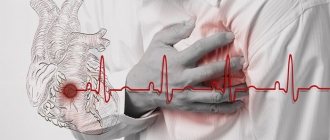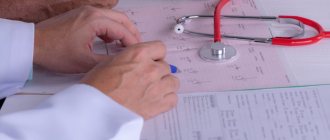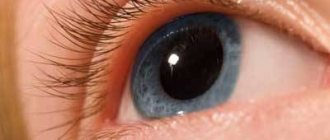Vegetative-vascular crises - these are psycho-vegetative symptoms that arise as a result of functional or morphological structures of the brain and are manifested by a variety of vegetative-neurological and endocrine-metabolic symptoms. In children, vegetative crises are mainly observed in prepubertal and pubertal age.
Differential diagnosis: hypoglycemic coma, attack of bronchial asthma, acute abdominal pathology, convulsive syndrome, hypertensive crisis.
Sympathetic adrenal crisis
Sympathetic adrenal crisis is typical for older children. There is a feeling of anxiety, fear; chills, headache, cardialgia, cold extremities, dry mouth, feeling of shortness of breath, numbness of lips and tongue, ringing in the ears, blurred vision, moderate fever and hypertension.
Emergency care for sympathoadrenal crisis
- Calm the child and put him to bed.
- Ingestion of tincture of valerian or hawthorn - 1 drop/year of life orally.
- Inject intramuscularly 0.5% diazepam solution 0.1 ml/year, but not more than 2 ml.
- For headache and fever, administer intramuscularly a 50% solution of metamizole sodium (analgin) 0.1 ml/year and a 2.5% solution of promethazine (pipolfen) 0.01 ml/kg.
Causes of vegetative-vascular dystonia
To get rid of vegetative-vascular dystonia, it is first necessary to identify the cause of the disease. An experienced neurologist can do this.
Autonomic dysfunction can occur for one of the following reasons or a combination of them:
- factor of hereditary predisposition (in this case, manifestations of VSD appear already in childhood)
- past acute and chronic infectious diseases or intoxication
- chronic psycho-emotional stress, depression, sleep disorders
- sedentary lifestyle, sedentary work and, as a consequence, poor posture and cervical osteochondrosis
- bad habits (smoking, drinking alcohol)
- as a consequence of chronic disease of the endocrine (hormonal changes), cardiovascular system, gastrointestinal tract and nutritional disorders
- diseases of the central and peripheral nervous system.
Vagotonic crisis
Vagotonic (parasympathetic or vagoinsular) crisis - manifested by complaints of weakness, sweating, vomiting, headache, abdominal pain, drooling. Characterized by hypothermia, low blood pressure, bradycardia, increased peristalsis, flatulence, oliguria, and a tendency to faint. More typical for younger children.
Emergency care for vagotonic crisis
- Put the child to bed, warm him, provide access to fresh air.
- Ingestion of Eleutherococcus tincture 1 drop/year of life.
- Inject subcutaneously 10% caffeine solution 0.1 ml/year of life.
- In case of severe bradycardia or intractable crisis, administer intramuscularly 0.1% atropine solution 0.1 ml/year of life.
Vegetovascular dystonia (VSD)
Vegetovascular dystonia (VSD) is one of the most common human diseases. According to modern statistics, more than 40% of adults and children have symptoms of vegetative dystonia.
Many people wonder what is vegetative-vascular dystonia? VSD is not a disease, but a collection of various syndromes associated with disruption of the central nervous system. VSD has the features of various diseases: psychological, neurological, cardiological, vascular, manifested by dizziness, increased sweating, rapid or slow heartbeat, difficulty breathing, sleep disturbance, unpleasant sensations in the limbs, fatigue, and weather sensitivity.
If you find yourself with signs of VSD, then you should not immediately self-medicate, but you should consult a doctor to rule out organic pathology, which may worsen with prolonged self-medication. Do not forget to contact your doctor once a year for an examination and take all necessary tests for early diagnosis of diseases and their prevention.
Research shows that no significant changes in the body have been identified during VSD, as well as structural disorders in the brain. But the person feels bad at the same time. In the course of various tests, it was found that with VSD, the delicate balance between the most important parts of the autonomic nervous system: sympathetic and parasympathetic is disrupted. In other words, with dystonia, a person’s blood vessels begin to respond inadequately to internal and external stimuli. As if for no reason at all, a person begins to feel dizzy and dizzy, his hands become sweaty, his heartbeat quickens, and he begins to feel short of breath. Thus, all symptoms are based on imbalance and disharmony of internal physical and biochemical processes.
Risk factors for VSD are:
- hormonal changes in the body;
- chronic stress and neuroses;
- overwork due to physical or emotional stress;
- alcohol abuse;
- severe and chronic diseases;
- consequences of injuries, infections, intoxications;
- disruption of the endocrine system.
Vegetovascular dystonia occurs in people of any age. In children, vegetative-vascular dystonia is often associated with a genetic predisposition. Vegetative-vascular dystonia in adolescents is usually caused by a mismatch in physical development and the degree of maturity of the nervous system. In general, as studies show, women are more often susceptible to vegetative-vascular dystonia syndrome after 25-30 years, men - after 40-45 years.
VSD can manifest itself in different ways, sometimes as single symptoms, sometimes as whole groups. Depending on the disturbances in the activity of one or another system of organs of manifestation
VSD is divided into several types:
- cardiac (heart) manifestations - pain in the heart area, rapid heartbeat (tachycardia), a feeling of a sinking heart, interruptions in heart function;
- respiratory (breathing) manifestations - rapid breathing, inability to take a deep breath, feeling of lack of air, feeling of heaviness, congestion in the chest; sudden attacks of shortness of breath;
- dysdynamic manifestations - fluctuations in arterial and venous pressure, disturbances in blood circulation in tissues; thermoregulatory manifestations - sharp, inexplicable fluctuations in body temperature - from 38 to 35 and below, and vice versa;
- dyspeptic manifestations - disorders of the gastrointestinal tract (abdominal pain, nausea, vomiting, belching, constipation or diarrhea);
- sexual disorders, for example, anorgasmia - lack of orgasm with persistent sexual desire;
- various dysfunctions of the urinary system - frequent, painful urination;
- psychoneurological manifestations - weakness, lethargy, decreased performance and increased fatigue, tearfulness, irritability, headaches, dizziness, weather sensitivity, disturbances in circadian cycles (sleep-wake), anxiety, shuddering during sleep.
Vegetative attacks (vegetative-vascular crises, panic attacks) usually make themselves felt at a fairly young age (20-40 years), mainly women suffer from VSD. If the activity of the sympathetic department predominates in the work of the ANS, then a sympathoadrenal attack (crisis) occurs, usually starting with a headache or pain in the heart, palpitations, redness or pallor of the face. The crisis is accompanied by an increase in blood pressure and body temperature, increased heart rate, chills, and in some cases, an attack of causeless fear.
Diagnosing VSD is not difficult. It can be carried out by the patient himself based on a number of simple signs - sudden pallor or, conversely, redness of the skin, especially on the face, frequent dizziness, darkening of the eyes, especially after sudden movements or standing up. There is a headache, mostly of a paroxysmal nature. Patients note increased sweating, rapid or slow heartbeat, interruptions in heart function, difficulty breathing, coldness or numbness in the arms and legs, and frequent feelings of weakness and weakness.
For a medical specialist, diagnosing VSD, on the contrary, is difficult, because its symptoms are varied and can be easily confused due to the similarity of the clinical picture with other neurological diseases. To diagnose VSD, electrocardiography (ECG), daily recording of an electrocardiogram, is used. To study the nervous system, electroencephalography is performed - a method of graphically recording bioelectrical impulses of the brain, computed tomography. Based on the results obtained, the doctor, relying on the examination data, as well as the patient’s complaints and the characteristic clinical picture of manifestations, makes a final diagnosis and develops a treatment regimen.
Of course, the ideal option is to prevent and treat VSD at a young age, when the first symptoms of the disease appear. It is a very common belief that VSD is a temporary condition, often observed during the development of a young organism, and will pass over time. Unfortunately, this opinion is erroneous - it has been proven that VSD that occurs in childhood or adolescence is an unfavorable background and a harbinger of many diseases.
In adults, the presence of symptoms of VSD requires, first of all, the exclusion of various diseases, the course of which is accompanied by dysfunction of the nervous system - endocrine pathologies (diseases of the thyroid gland, adrenal glands, sexual dysfunctions), various mental disorders (from neurosis, neurasthenia to diseases caused by significant changes in brain structures). Many chronic diseases are accompanied by manifestations of VSD, so in any case, an urgent visit to a doctor is simply necessary.
Treatment of VSD , of course, is individual, but the program always includes three mandatory stages: identification and elimination of the main cause of the disease, basic treatment and non-drug therapy, which rather has a rehabilitation and preventive value. Swimming and running are recommended for everyone, regardless of age, they are one of the most useful sports because they involve long-term and uniform load on all muscles, this also includes skiing, cycling, etc.
Proper balanced nutrition also plays a role. The diet should always include cereals, vegetables, herbs, fruits, less fat, and sugar. All this has a beneficial effect on metabolism. Fish is healthy, but meat should not be the main food product. Alcohol, with frequent and increased consumption, can lead to an imbalance in the nervous system and become one of the manifestations of the symptoms of VSD.
For relaxation and stress relief at the end of the day, it is advisable to take baths with a small amount of essential oils (thyme, pine, spruce, fir, rosemary, rose, etc.). A contrast shower will be an excellent way to train blood vessels. You need to monitor the time of work and rest, maintain a sleep schedule, try to avoid overwork and overexertion, i.e. everything that can lead to VSD. A child should play sports from early childhood; it is advisable to exempt him from physical education only as a last resort.
Drug treatment is carried out only under the supervision of a doctor - there are no “magic pills” for VSD. Treatment of VSD is complex and necessarily includes potassium and calcium supplements, vitamin and mineral complexes, vascular drugs, nootropics (drugs that improve nutrition, metabolism and the functioning of brain cells), antidepressants. Treatment of vegetative-vascular dystonia depends on the severity of the disease. As a rule, this treatment is complex and includes physiotherapy, herbal medicine, psychotherapy, and, if necessary, consultation with a chiropractor or acupuncturist.
If you discover signs of VSD, then you should not immediately self-medicate, but you should consult a doctor to rule out organic pathology, which may worsen with prolonged self-medication. Don’t forget to contact your doctor once a year for an examination and all the necessary tests for early diagnosis of the disease and its prevention.
Mixed and hysteroid crises
Mixed crisis - characterized by a combination of the above symptoms.
Hysterical (fainting-tetanic) crisis - characterized by tachycardia, hysterical hyperventilation, increased blood pressure, tremor and local convulsions, but there may also be generalized tetany.
Emergency care for mixed and hysteroid crisis
- Inject intravenously or intramuscularly 0.5% seduxen solution 0.05 ml-0.1 ml/kg, but not more than 2.0 ml.
- In case of incomplete relief of a convulsive state, administer 20% sodium hydroxybutyrate solution 0.25-0.5 ml/kg intravenously.
Symptoms and manifestations of VSD
A dysfunction of the autonomic nervous system can affect one or several organs at once. Depending on this, there are several types of vegetative-vascular dystonia (also called syndromes), each of which manifests itself in its own way.
| Syndrome | Symptoms |
| hypertensive syndrome | increased heart rate, short-term increase in blood pressure (up to 140-170/100 mm Hg), which decreases without taking medications |
| hypotensive syndrome | decreased blood pressure to 90/60 mm Hg, headaches, weakness, dizziness, cold hands and feet |
| cardialgic syndrome | symptoms resemble angina pectoris, but are not associated with physical activity: nagging, bursting pain and burning in the heart area behind the sternum |
| tachycardial syndrome | increased heart rate up to 90-120 beats per minute, increased blood pressure, a feeling of vibration in the head, redness of the face |
| asthenic syndrome | weather dependence, physical weakness and fatigue in the morning, worsening in the evening, decreased attention, ability to work, and in a lying position - comfortable well-being |
| visceral syndrome | intestinal dysfunction, pain and bloating, flatulence, indigestion |
| respiratory syndrome | soreness and feeling of a lump in the throat, inability to take a deep breath, pain and tightness in the chest |
| mixed form | combination of two or more VSD syndromes |
If vegetative-vascular dystonia is not treated
Any form of vegetative-vascular dystonia significantly affects the quality and lifestyle of a person, depriving him of the opportunity to work and live normally. In severe cases, VSD can be manifested by loss of consciousness, increased heart rate and other dangerous conditions. In addition, if vegetative-vascular dystonia is not treated and controlled, it can develop into serious diseases of those organs in which the balance between the sympathetic and parasympathetic parts of the nervous system is disturbed:
- heart (hypertension, ischemia, stroke and heart attack)
- stomach and intestines (intestinal atony (hypotonicity), gastritis)
- kidneys and genitourinary system (urinary incontinence, diseases of the reproductive system in men and women)
- psyche and nervous system (convulsions, panic attacks).
All syndromes associated with vegetative-vascular dystonia are characterized by periodic exacerbations - crises or attacks. During an attack of VSD, all manifestations of the syndrome sharply worsen (tachycardia, fainting, shortness of breath), accompanied by a panic attack for no apparent reason. Such attacks can last a short or long time, and then pass without a trace.
Migraine-like crisis
Migraine-like crisis - paroxysmal sharp headaches, nausea, vomiting, increased blood pressure, dizziness.
Emergency care for a migraine-like crisis
- Inject intramuscularly in one syringe:
- 50% solution of metamizole sodium (analgin) 0.1 ml/year
- 2.5% solution of promethazine (pipolfen) 0.01 ml/kg
- 2% papaverine solution 0.1 ml/year of life.
- Inject intramuscularly or intravenously 1% solution of furosemide (Lasix) 0.1-0.2 ml/kg.
- Inject intramuscularly 0.5% solution of metoclopramide (cerucal) 0.01 ml/kg.
- For severe bronchospasm - intravenously 2.4% slow aminophylline 0.1 ml/kg.
Categories
There are two types of classifications of PA (panic attacks). For reasons of occurrence:
- situational. The feeling of horror, as well as other symptoms, appear only in a certain situation, which has a negative impact on the person and his body as a whole;
- spontaneous. Can occur at any time, regardless of place, time or emotional state at the current moment;
- conditional-situational. It only appears when exposed to chemicals. For example, alcohol or tobacco.
By VSD type:
- hypotonic type. It is characterized by sweating, decreased blood pressure, shortness of breath, nausea and body weakness;
- hypertensive. In this type, the most common symptoms are rapid heartbeat, rapid pulse and increased blood pressure;
- mixed. The patient experiences two types of panic attacks at once during VSD.
Symptoms
The manifestation of panic attack syndrome is varied, as it depends on the part of the autonomic nervous system. The main symptom was and remains a sudden feeling of intense uncontrollable fear. But besides this, there are some other symptoms of the disease:
- labored breathing;
- a sharp jump in body temperature;
- cold sweat;
- numbness or pins and needles sensation;
- headache;
- cardiopalmus;
- diarrhea;
- nausea;
- discomfort and pain in the heart area;
- dizziness;
- trembling in the limbs and throughout the body;
- increased blood pressure.
A panic attack can last from 30 seconds to an hour and a half.
Vegetative-vascular dystonia: persistent symptoms
- Cardialgia. Pain in the left side of the chest that is not due to heart damage. These symptoms are not specific to VSD; they can occur in many other diseases.
- Heartbeat problems . Common symptoms of VSD are rapid or slow heartbeat, irregular heart rhythm (arrhythmia).
- Vascular dystonia . Constriction of blood vessels causes blood flow to slow down. Because of this, internal organs suffer, which do not receive enough oxygen and nutrients.
- Respiratory disorders . Shortness of breath, difficulty breathing, feeling of lack of air.
- Systemic neurotic disorders . The patient suffers from insomnia and nervousness.
Consequences of VSD
Despite the fact that vegetative-vascular dystonia manifests itself quite severely, it has a positive prognosis. Of course, the risk of developing negative consequences is directly influenced by strict adherence to medical recommendations, especially regarding adherence to a daily routine, giving up bad habits and taking prescribed medications.
With a careful approach to the treatment of VSD, the risk of developing undesirable consequences is minimal. But if the problem is ignored, patients have a high chance of later encountering:
- tachycardia;
- hypertension that cannot be treated with traditional drugs to lower blood pressure;
- cardiomyopathy;
- diabetes mellitus type 2;
- urolithiasis and cholelithiasis;
- stroke, myocardial infarction.
VSD negatively affects the immune system. Therefore, patients with this diagnosis are much more likely than others to suffer from respiratory infections. In this case, a vicious circle is formed, since in acute respiratory infections attacks are observed more often.
5 2 votes
Article rating
Treatment of VSD: lifestyle correction and diet
To get rid of VSD, you need to eliminate the cause of the disease and normalize the functioning of the autonomic nervous system. This will help you:
- Full sleep. It is important to sleep at least 8 hours a day and go to bed at the same time. To ensure a restful sleep, it is advisable not to overeat at night, open windows for ventilation and ensure a comfortable temperature in the room.
- Healthy eating. Animal fats should be replaced with vegetable fats, which are found in nuts, grapes, and olives. It is better to exclude or reduce the amount of fatty, fried foods.
- Physical exercise. If there is no time for regular training, morning exercises, regular walking or cycling will be enough.
- Massage. Massage of the head and collar area helps against headaches due to VSD, and massage of the torso and limbs helps against low blood pressure.
To find and treat the root cause of VSD, contact the doctors at the Medicenter clinic. Specialists will conduct an examination, identify the problem and prescribe effective treatment.
Diagnostics
To diagnose and prescribe treatment for VSD, you must consult a neurologist. Before the consultation, it is best to make a detailed list of complaints. This will help the specialist not only detect VSD, but also suggest what caused its development. The doctor will definitely conduct a thorough survey, during which he will also find out the presence and nature of the prerequisites for the development of vegetative-vascular dystonia.
Then the neurologist proceeds to the examination. The doctor assesses the condition of the skin, measures the pulse, blood pressure, sometimes using an orthostatic test (2 measurements are taken: one in a lying position, the second after taking up a vertical position), listens to the lungs and heart. To assess the activity of the sympathetic and parasympathetic autonomic nervous system, he may pass the end of the hammer handle over the skin.
After completing the examination and assuming the presence of VSD, the neurologist must prescribe a set of studies that will help detect or confirm existing assumptions about the causes of the development of the disorder. For this purpose, patients are prescribed:
- UAC and OAM;
- blood sugar test;
- blood test for TSH, T3 and T4 (thyroid hormones);
- biochemical blood test to determine the concentration of potassium, cholesterol, creatinine, urea and other compounds;
- ECG;
- fluorography of the chest organs;
- rheoencephalography;
- MRI;
- Ultrasound scanning of neck vessels;
- EEG.
In our clinic, you can also learn in more detail about the composition of your body and the state of the vascular system, which is involved in the blood supply to internal organs, skeletal muscles, and the brain. Our experienced doctors will explain the data obtained to you in detail. Bioimpendansometry calculates the ratio of fat, muscle, bone and skeletal mass, total fluid in the body, and basal metabolic rate. The intensity of recommended physical activity depends on the state of muscle mass. Metabolic processes, in turn, affect the body's ability to recover. Based on the indicators of active cell mass, one can judge the level of physical activity and nutritional balance. This simple and quick test helps us identify disturbances in the endocrine system and take the necessary measures. In addition, it is also very important for us to know the condition of blood vessels for the prevention of diseases such as heart attacks, hypertension, heart failure, diabetes and much more. Angioscan allows you to determine such important indicators as the biological age of blood vessels, their stiffness, stress index (which indicates heart rate), and blood oxygen saturation. Such screening will be useful for men and women over 30, athletes, those undergoing long-term and severe treatment, as well as everyone who monitors their health.






